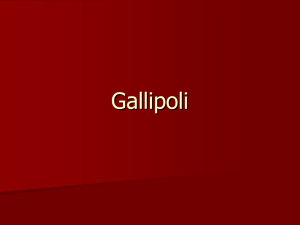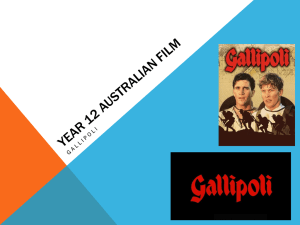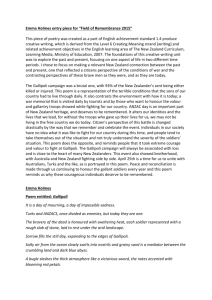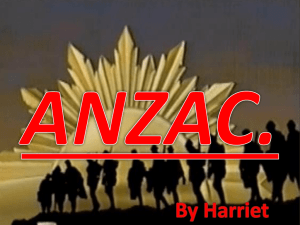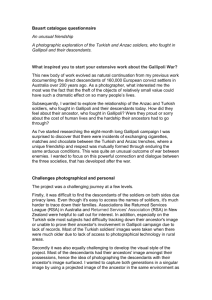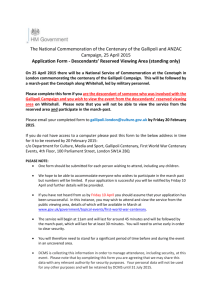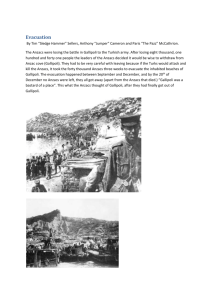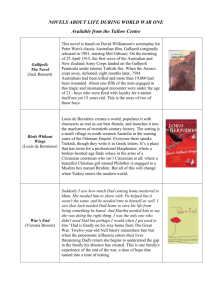revealing gallipoli
advertisement
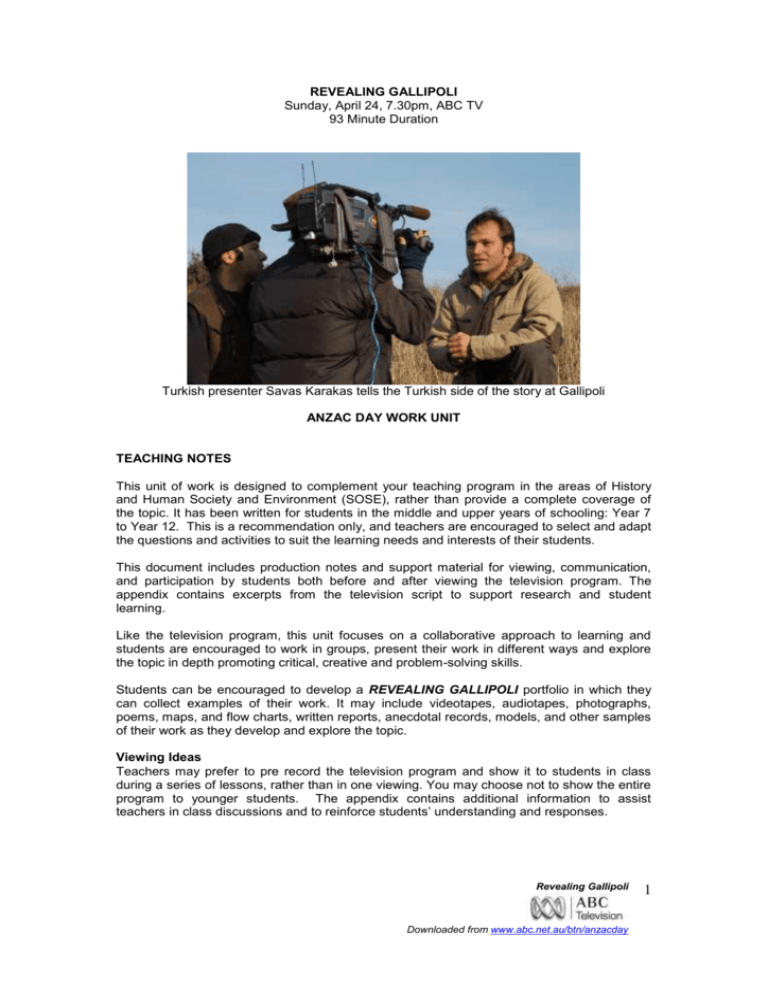
REVEALING GALLIPOLI Sunday, April 24, 7.30pm, ABC TV 93 Minute Duration Turkish presenter Savas Karakas tells the Turkish side of the story at Gallipoli ANZAC DAY WORK UNIT TEACHING NOTES This unit of work is designed to complement your teaching program in the areas of History and Human Society and Environment (SOSE), rather than provide a complete coverage of the topic. It has been written for students in the middle and upper years of schooling: Year 7 to Year 12. This is a recommendation only, and teachers are encouraged to select and adapt the questions and activities to suit the learning needs and interests of their students. This document includes production notes and support material for viewing, communication, and participation by students both before and after viewing the television program. The appendix contains excerpts from the television script to support research and student learning. Like the television program, this unit focuses on a collaborative approach to learning and students are encouraged to work in groups, present their work in different ways and explore the topic in depth promoting critical, creative and problem-solving skills. Students can be encouraged to develop a REVEALING GALLIPOLI portfolio in which they can collect examples of their work. It may include videotapes, audiotapes, photographs, poems, maps, and flow charts, written reports, anecdotal records, models, and other samples of their work as they develop and explore the topic. Viewing Ideas Teachers may prefer to pre record the television program and show it to students in class during a series of lessons, rather than in one viewing. You may choose not to show the entire program to younger students. The appendix contains additional information to assist teachers in class discussions and to reinforce students’ understanding and responses. Revealing Gallipoli Downloaded from www.abc.net.au/btn/anzacday 1 Line of Turkish soldiers. Photo courtesy Australian War Memorial. BACKGROUND INFORMATION Revealing Gallipoli tells the story of a nine- month battle, which ended with the evacuation of all its troops in December 1915. Some 450,000 people are killed or wounded. Almost nothing is accomplished. By 1915 the First World War was faced with a deadlock; lines of German and French/British (allied) forces faced each other from Switzerland to the English Channel. The Ottoman Empire was an ally of the Germans; Australia was on the allied side. The Australians are part of a great multinational force that lands in Turkey on April 25, 1915. This force is to secure the Dardanelles, a narrow strip of sea twisting like a river from the Aegean, to the Sea of Marmara. Having secured the Dardanelles, British and French battleships can steam to the very gates of Istanbul, and knock Turkey out of the Great War. This plan failed and so they decided to attack by land. It is a good plan. It could work. But it is a plan cobbled together, under-equipped, undermanned and poorly commanded. In short, it is badly planned. The Turks are defending their homeland. They fight ferociously. For the Turks, Gallipoli is also a founding event in the story of their nation. Both Turks and Australians revere Gallipoli, and this may be the most extraordinary legacy of the battle. What remains, despite the ferocity and the heartbreak and the 90-year-old bones, is a deep respect, a deeper friendship, and a shared honour. KEY DATES 1914 August 4 Australia enters World War I Revealing Gallipoli Downloaded from www.abc.net.au/btn/anzacday 2 October 31 November 1 December 3 1915 March 18 The Ottoman Empire becomes an ally of Germany in the war The first convoy of troops leaves Australia for the war This Australian convoy arrives in Egypt for training British and French naval forces fail to force a way through the Dardanelles April 25 The landing of allied troops at Anzac Cove and Cape Helles May 24 One day truce to bury the dead August 6 – 9 The Battle of Lone Pine August 7 The charge at the Nek August 29 The end of the August (failed) offensive December 7 A decision is reached to evacuate Gallipoli December 19 - 20 Completion of the evacuation of Australians from Gallipoli Source: Australian War Memorial PRODUCTION NOTES Making Revealing Gallipoli was a daunting task. Behind the legend is a story of ordinary young men in extraordinary circumstances from more nations than just Australia and New Zealand. Making the film was an opportunity to tell their stories, and that of the battle they fought in the land where the legends began. And this new production had to be different from the past. The most profound difference was that there are no remaining veterans from the campaign. What would connect the audience with the past? What was the new story? How could we view the battle differently? There have been many stories about the ANZAC legend at Gallipoli, but few of us have heard the incredible experiences of all the other nations that fought side-by-side with the Australian and New Zealand troops. It’s time to broaden our view. That is what makes this program different. Developed with the assistance of the Australian Film Commission and Film Victoria, Melbourne-based December Films spearheaded the project, producing it in association with ABC TV, Turkish Radio and Television, TVNZ (New Zealand), S4C, S4C International (Wales) and RTE (Ireland). Director: Wain Fimeri Producer: Tony Wright Executive producer: Stephen Amezdroz Executive producer ABC TV: Head of Documentaries Stuart Menzies The presenters are the Australian War Memorial’s principal historian Dr Peter Stanley, Turkish filmmaker Savas Karakas – the grandson of a Gallipoli veteran - and prominent Irish historian Professor Keith Jeffery. ON THE GROUND Who was involved? Revealing Gallipoli Downloaded from www.abc.net.au/btn/anzacday 3 Mounting a production of such scope was a challenge and involved the co-operation and involvement of five international broadcasters; Australian production company December Films with broadcasters from Wales, Ireland, Turkey and New Zealand. It proved to be a complex task of legal issues, logistics and language, as each broadcaster had differing requirements for their final version. Director Wain Fimeri began work on a script that would reflect the differing needs of all broadcasters – each broadcaster would also shoot additional scenes to slot into their own versions. How would it look different to past programs? Computers would bring alive the archival stills that they would find in every country involved some unseen for decades. Vision came from all sources, from an old cottage near Dublin, the military archive in Turkey, family trusts and to the major war museums in the UK and Australia. What were some differences? The New Zealand version replaced the Aussie with a Kiwi presenter. The Welsh version replaced the Irish and Australian presenters with two of their own, but retained the Turkish presenters. December Films had to produce separate versions in Welsh and Turkish languages. ABC Australia wanted a 90-minute version of the program, while the international broadcasters all required 2 x 1 hours. How did it happen? Australian, Irish and Turkish presenters travelled to Gallipoli, to shoot their scenes on the ground on which the actual battles took place. Like General Hamilton, December Films planned the shoot in Gallipoli without the benefit of an existing map for handling a task of such complexity. And it all had to be completed before the winter snow! Fortune favours the brave, and the production crews managed to shoot from December 2004 all the way through to late January 2005, where the snow held off until the very last day. The December Films crew returned to Melbourne to begin the assembly of a total of 13 differing versions, all in time for the 90th anniversary of the landings. What was an advantage of doing it this way? This challenging collaboration allowed each player to produce a much higher quality production than they would have been able to alone. PRESENTER BIOGRAPHIES Australia Dr Peter Stanley, principal historian at the Australian War Memorial. Dr Peter Stanley is Principal Historian at the Australian War Memorial, where he has worked since 1980. Revealing Gallipoli Downloaded from www.abc.net.au/btn/anzacday 4 An authority on Australian military history before 1945, he has worked on many of the Memorial's exhibitions (including the Gallipoli Gallery) and has published 18 books, most recently For Fear of Pain: British Surgery 1790-1850, and Quinn's Post, Anzac, Gallipoli, which is about to be published by Allen & Unwin to mark the 90th anniversary of the campaign. His next books will be on Australia in the Second World War and on the battle of Mont St Quentin in 1918. He has conducted fieldwork on battlefields in Europe, Africa and Asia, including Gallipoli. Turkey Savas Karakas, filmmaker and grandson of a Gallipoli Veteran. Savas is a well-known Turkish television personality and the host of a number of entertainment programs. His career in the film and television industry has seen him working on both sides of the camera. His interest in Gallipoli was ignited when reading the diaries of his grandfather, Hafiz Hilmi, a veteran of World War 1 and the Turkish War of Independence. Savas has a number of credits to his name, including the two-part program on the loss of the Turkish submarine, the Dumlapinar, which sank in the Dardanelles in 1953 after a collision with a Norwegian freighter. Only a handful of the submarine’s crew survived the disaster, one of the greatest tragedies in the history of the modern Turkish navy. Savas also produced History in the Depths, a documentary showing the first underwater footage of the battleships sunk around the Gallipoli Peninsula, and which told the story of the naval contribution to the battle. He is currently producing a documentary about the lost and forgotten submarines of the Dardanelles. Ireland Professor Keith Jeffery, historian Keith Jeffery was born and raised in Belfast, Northern Ireland. He was educated in Belfast, the USA, and at Cambridge University. Since 1997 he has been Professor of Modern History at the University of Ulster. In 1997-98 he was a Visiting Scholar at the Australian National University and the Australian Defence Force Academy. For ten years he was editor of the leading Irish history journal, Irish Historical Studies, and is currently chair of the journal’s Board of Management. He has been a member of the Royal Irish Academy National Committee for History since 1985, and has represented Ireland at numerous international meetings. He is the author or editor of ten books, including A Military History of Ireland (with Thomas Bartlett), The Sinn Fein Rebellion As They Saw It, and Ireland and the Great War (the Lees Knowles Lectures). Professor Jeffery is a Trustee of the Ulster Historical Foundation, the leading family and local history organisation in Northern Ireland. He is currently working on a biography of Field Marshal Sir Henry Wilson, the Irish-born Chief of the (British) Imperial General Staff who was assassinated on his London doorstep in 1922 by two IRA men. PRODUCTION BIOGRAPHIES Writer / director Wain Fimeri Wain has a consuming interest in history, people and stories. His credits include writer/director for the award-winning television features, Love Letters from a War (2003), and Pozieres (2002). Prior to that, he wrote a number of projects for film and television. Revealing Gallipoli Downloaded from www.abc.net.au/btn/anzacday 5 Wain also has an extensive background in photography, art and graphic design. His work has been exhibited throughout the world. Producer Tony Wright Tony Wright founded December Films in the early ’90s. Since then the company has expanded from award-winning educational producer to becoming a significant player in the Australian film and television production industry, with expanding overseas working relationships and a long list of successful documentary credits such as Grey Nomads and Grey Voyagers. In recent years the company has also extended its business into children’s television (animation series and live action) and adult drama. However, documentary remains a core part of the December Films slate, with recent expansion into the areas of history and science. Executive producer ABC TV – Stuart Menzies Stuart Menzies is the Head of Documentaries, ABC Television. Stuart has an extensive background as an independent filmmaker, having worked in the film and television industry for more than 20 years. Originally working as a historical consultant, his credits as producer now include a number of successful documentaries including Mama Tina, Grey Voyagers and Auto Stories. For further information contact: Laurelle Keough ABC TV Publicity Tel (03) 9524 2313 keough.laurelle@abc.net.au Revealing Gallipoli Downloaded from www.abc.net.au/btn/anzacday 6 COMMUNICATION Where is Gallipoli? What happens at Gallipoli today? How did the Turkish people feel about Winston Churchill confiscating the two battleships they had paid for? These battleships were described as a symbol of Turkish pride and honour. What does this mean? How was World War I declared? How did the Turks get ‘drawn into the first world war?’ Describe what happened on the day of victory for the Turkish people. What was Fisher’s reaction to the loss of the battleships? How did the acronym ANZAC come about? Rupert Brooke dies two days before the landing. How does he die? Rupert Brooke’s death is described as an omen. Why? The plan to capture the Turkish forts involved landing men at six beaches; S,V,W,X and Y and Z. Which letter was used to mark the beach for the ANZACS? Why do you think letters were used to mark the locations? How did some of the allied forces create a diversion so the Turkish soldiers would think they were in the chosen spot for a landing? Joe Murray described the diversion mission as a ‘suicide party”. Would you agree? Give reasons. Compare the conditions and battles that took place in the six different landing beaches. What forms of communication were used? How did this influence the outcome? What impression do you have of the Turkish soldiers? Did your impression change? Explain. Is there such a thing as a ‘typical soldier’? Explain. Why did some of the soldiers enlist? How did the soldiers feel about their experiences? What kind of evidence was left behind after the nine-month battle? What did it reveal? How would capturing the Gallipoli Peninsula have helped capture Constantinople? What were some strengths and weaknesses of the plan to capture the little village of Krithia? How did the health of the soldiers influence the outcome of the battle? The Turks said ‘gule, gule’, which means ‘smiling you may go, and smiling you may come again’. What would soldiers from other nationalities have said to mean the same thing? Why was Gallipoli considered a failure? What were the different reactions to the failure of the Gallipoli campaign? What different religious faiths would have been practiced at Gallipoli? What do you recall about the battle at Lone Pine? How important were letters, poems and songs to the people at Gallipoli? Why? What were some similarities and differences between the first landings and the evacuation? Why do you think some of the soldiers left gifts in their trenches? What happened to the leaders after the soldiers left Gallipoli? What attitudes to war do you have after watching this documentary? Why? Finish the following sentence: The battle might have been different if ... Did the television program live up to your expectations? Explain. What difference did it make showing black and white vision? What challenges would the production team have had to overcome when filming the recreation scenes? What contribution did the presenters make to the story? Revealing Gallipoli Downloaded from www.abc.net.au/btn/anzacday 7 VIEWING PART ONE – INTRODUCTION TO THE BATTLE (01 00 00 00 01 – 01 29 00 07) LEARNING OUTCOMES Students will learn to: Understand the origins of the battle on Gallipoli. Identify where Gallipoli is located. Identify who was involved in the battle, from the decision makers to the soldiers on the ground. Understand how the First World War began and why Australia became involved. Identify and analyse the consequences of the British confiscation of two battleships, paid for by the Turkish people. Examine reasons for the battle on Gallipoli from different points of view. Understand why people were chosen for the roles they would play in the battle. Appreciate and understand reasons why men from Britain, (Ireland, Wales, Scotland, England) France, Newfoundland, New Zealand, Australia, India and Turkey enlisted and were involved in the battle. (00 22 40 23 – 01 23 21 22 includes references to brothels which may not be suitable for all students!) PART TWO - THE PLAN (01 29 00 07 - 01 48 54 19) LEARNING OUTCOMES Students will learn to: Appreciate the experiences of the soldiers who fought at Gallipoli. Use primary sources to compare different eyewitness accounts of events at Gallipoli. Investigate the consequences of the diversion on the Turks and the Allied forces. Make comparisons between the old ship (The River Clyde), which was sent ashore, and a ‘Trojan Horse’ Appreciate and analyse the reaction by the soldiers. Compare reasons why the ANZAC landing was chaotic? Investigate different evidence, which shows where the parties reached. Analyse why different battles were fought on different beaches. Investigate why the landing seemed doomed to fail. PART THREE - RIVER CLYDE & LONE PINE (01 48 59 00 – 02 32 34 19) LEARNING OUTCOMES Students will learn to: Understand and compare views of how the invasions were carried out. Identify procedures for supplying equipment and provisions. Understand and appreciate different points of view about the plan to capture the forts. Recognise and compare difficulties faced with the capture of Krithia. Analyse interpretations of the achievements at Gallipoli. Recognise the contribution of Gallipoli to the ‘ANZAC legend’. Appreciate and consider the different religious beliefs held by the people in the battle. Understand the battle of Lone Pine and how it affected the soldiers and the overall plan. Analyse why Gallipoli was considered a failure and a ‘defining moment’ in history. Revealing Gallipoli Downloaded from www.abc.net.au/btn/anzacday 8 BEFORE AND AFTER Present the following questions to your students before and after viewing the television program. Before 1. What are you most curious about? 2. The part of the Gallipoli story that I know the most about is... 3. When I think about being a soldier at Gallipoli, I ... (Consider this from the points of view soldiers from different nationalities.) 4. I am hoping to learn about ... 5. I expect to see ... 6. My image of a Gallipoli includes ... After 1. 2. 3. 4. 5. 6. One aspect I found interesting was... One thing that was new to me was ... Did the television program live up to your expectations? Explain. I changed my mind about ... because ... If I could have changed one decision made by a leader on the battle it would be to ... Write two positive statements about things you have learned about loss and friendship after watching this television program. 7. I had some difficulty understanding .... 8. I liked the .... 9. Which scene do you remember most vividly? Why? PARTICIPATION Discuss why different presenters were used in the making of Revealing Gallipoli. Research the accents that would have been heard on the peninsula. Select one person listed in the appendix below and rehearse and present a short comment by this person. (Teachers note: Encourage students to treat this activity with respect in an effort to appreciate and understand differences between accents rather than making fun of them.) In small groups discuss how the soldiers must have felt at the following point in the battle? What strategies do you think they used to ‘appreciate the situation’? “Soldiers were forced to disembark from the River Clyde. They could not escape the Turkish bullets and the colour of the sea changed with the blood from their bodies. One of the soldiers said: “...Then I jumped into the sea. There was a small, rocky spit and few, if any, survived an attempt to land there. We all made, Dublins and all, for a sheltered ledge on the shore, which gave us cover. Here, we shook ourselves out and tried to appreciate the situation.” Imagine you are one of the people listed in the appendix below. Write a letter home. Include comments about at least three of the following: Food Shelter Exercise and relaxation Washing and health Friendship Loss and grief Revealing Gallipoli Downloaded from www.abc.net.au/btn/anzacday 9 Locate Anzac Cove and Gallipoli using an atlas. Recall the landing locations displayed on the animated maps on the television program. Design and make a labelled 3D model showing the peninsula, six landing beaches and key Turkish strongholds. Imagine you are a soldier who survived the battle on Gallipoli. Retell the story of the battle on Gallipoli in your own words. Has your story changed after watching ‘Revealing Gallipoli’? If so, how? Write two opposing statements that reflect what two different soldiers might have felt about their role in the battle on Gallipoli. Display these statements in the classroom and ask other students to guess who they think wrote the statement and why. Read the excerpt from William Malone’s letter to his wife below. In pairs draft a response by his wife. “ I regret very much now I lost more happiness than I need have done. Forgive also anything unkindly or hard that I may have said or done in the past. My desire for life so that I may see and be with you again could not be greater.” In small groups analyse the poem written by Major Jack Churchill, Winston’s brother, in relation to Y beach: “Y Beach, the Scottish borderer cried, While panting up the steep hillside To call this thing a beach is stiff It’s nothing but a bloody cliff.” Consider questions such as: Where do you think Jack wrote the poem? What did he write it on? Do you think it likely that he would have shared his poem with his mates and family back home? What do you think his mates would have thought about his poem? Give reasons. Choose one of the six beaches; S,V,W,X, Y and Z and imagine you are a soldier fighting in that location. Write a poem or draw a story map about your experience. Working in pairs or small groups, consider and list how aspects of the battle on Gallipoli might have been different if one of the following forms of technology could have been used in 1915. Mobile Phone or Two Way Radios Night Vision Glasses Computers Global Positioning System Jet fighters List some of the foods prepared and eaten by soldiers on Gallipoli. Find a recipe that is likely to have been eaten by a group of soldiers and prepare a step-by-step set of instructions to make it at one of the locations on the peninsula. Revealing Gallipoli Downloaded from www.abc.net.au/btn/anzacday 10 In groups of four, make up, rehearse and present a short play about one of the events in the battle on Gallipoli. For example, waiting on a small boat while one person decides to swim from the boat and light flares on the beach to act as a diversion. Create a timeline of events showing the key developments in the Gallipoli campaign. Draw, compose a song or paint a picture to describe one aspect of Gallipoli. Colonel Godfrey Matthews, of the Plymouth Marines believed he was in charge of the landing, and so did Colonel Archibald Koe of the Kings Own Borderers. His men landed first and they argued while their soldiers were sitting down making tea on top of the cliffs. Two thousand invaders didn’t know that there were only one thousand Turkish defenders on the tip of the entire peninsula. What do you think they are likely to have said? What was the likely outcome? What were some disadvantages and advantages of arguing in front of the soldiers? In pairs plan and conduct an alternative way to settling a dispute over leadership. Joe Murray and his mates were sent in the rowboats to create a diversion. They wanted the Turkish soldiers to think they were in the chosen spot for the allied landing. They were given as much steaming cocoa as they could drink and referred to it as the last supper. Imagine you were in the boat with Joe. Prepare an audio tape recording of the conversation that might have taken place as they waited in the boat. Include references to what you might see, feel, hear and think. Imagine you have been asked to go in a boat and act as a decoy. You can choose three other soldiers to go with you. Explain what skills or personality traits you would like these people to have. As a class talk about why some soldiers left a present for the Turks. Roleplay what might have happened when the following present was found. “I personally left in my own dugout a bottle of whisky, and I left a little scrap of paper with it, on which I’d written, a present for a good Turk. And that’s what I left behind in my dugout on Gallipoli.” Discuss the purpose of posters about Lord Kitchener. In groups of four, discuss and develop three conclusions about what it might have been like to be one of the following leaders from the appendix below. Create a poster for one of these leaders. List the skills and characteristics you would need to be a good leader in a conflict like the battle on Gallipoli. In small groups rank these characteristics from most to least important and say why. Choose one leader from the appendix list and rank him according to the list of characteristics you have prepared. Design a soldier’s uniform using a fabric that would have been suitable for a soldier to wear at Gallipoli in 1915. Revealing Gallipoli Downloaded from www.abc.net.au/btn/anzacday 11 In a small group, prepare a flow chart to illustrate the sequence of events in the battle on Gallipoli. Recall how soldiers felt about gifts they received from their families. Read the following two quotes and write three other comments from soldiers of different nationalities who fought in the battle. “The best present I ever had sent to me, my Dad sent me over a couple of tins of curry, and they were worth their weight in gold.” Australian soldier “My Dad also came to see me at Ari Burnu. My Dad bought halva, yoghurt and eggs. Other boys Dads came too.” Turkish soldier Design and make a Gallipoli campaign medal. Visit your local memorial and research a name on it. Imagine you are one able to interview one of the television presenters in ‘REVEALING GALLIPOLI.’ Working in pairs draft ten questions you would like to ask the presenter about the making of this documentary. Role-play the interview and make a recording of it to share with other students. 2005 is a year of significant anniversaries for Australia’s military history. Apart from April 25 being the 90th anniversary of the Gallipoli landing, other events include: May 8, 60th anniversary of Victory in Europe Day (VE Day) July 26, 90th anniversary of the AIF second division August 15, 60th anniversary of VP Day (Victory in the Pacific) Investigate how these milestones are being commemorated in your local area. Take photographs and present a PowerPoint format or poster display, with appropriate captions and statements about these events. Students can examine a range of sources and images on the Australian War Memorial website and others listed in the appendix below. APPENDIX Some Useful Links and Resources Additional teaching resources can be downloaded from the following websites: Australian War Memorial www.awm.gov.au Department of Veterans’ Affairs http://www.anzacsite.gov.au/1landing/index.html www.dva.gov.au Revealing Gallipoli Downloaded from www.abc.net.au/btn/anzacday 12 Commonwealth War Graves Commission www.cwgc.org Download and construct a biography of Alec Campbell – the last Gallipoli ANZAC. www.anzacday.org.au National Centre for History Education www.hyperhistory.org Operation Click Anzac to Kokoda. Department of Veterans’ Affairs. ISBN 1877007 20 X, March 2005 Discovering Democracy www.curriculum.edu.au/democracy/ddunits Resource: ‘We remember’ Working the Web: Investigating Australia’s wartime history. Department of Veterans’ Affairs, 2004. Australians at War Primary Schools Education Resource, ‘Creating your summary of WWI’, Dept. of Veterans’ Affairs, 2002 Australians at War Secondary Schools Education Resource, Unit 2, ‘Experiences of War’ Dept. of Veterans’ Affairs, 2002 Anzac a day to remember, Jo Pillinger and Amy Hibberson. Australian War Memorial ISBN 0 – 642-70436-8, 1999. Estimated Death figures show that there were many nations who lost their sons and fathers – chief amongst them were the Turkish soldiers who were defending their homeland. (Figures are all approximate) Country Turkey Britain (Ireland, Wales, Scotland, England) France Australia New Zealand India Newfoundland ‘REVEALING GALLIPOLI’ Estimated Deaths 86,000 21,300 9,800 8,700 2,700 1,400 50 LIBRARY OF FACTS The acronym ANZAC came about because one of the headquarters clerks in the corps headquarters needed to shorten the title and had a rubber stamp made. This was late in 1914, in Cairo. The official historian, Charles Bean, wrote that: "Possibly the first occasion" when the word ANZAC was used was when one sergeant clerk asked another to "throw him the ANZAC stamp". About 50,000 Australians took part in the Gallipoli campaign: more than 8,000 died as a result. Troops from eight countries served on Gallipoli: Turks and Germans fought against British, French, Australian, New Zealand, Indian and even Newfoundland troops. The Newfoundland Regiment (from what is now part of Canada) served on Gallipoli from September to December. It lost 50 dead. Revealing Gallipoli Downloaded from www.abc.net.au/btn/anzacday 13 No one knows exactly how many Turks died in the campaign. Three-quarters of the Australian dead on the Gallipoli peninsula have no known grave: they are commemorated on the Australian memorial at Lone Pine. The Australian submarine AE2 played a decisive role in the campaign. Even though it was sunk its success encouraged the British commander to decide against a hasty evacuation. Medical arrangements in April and August failed in the face of huge casualties: some wounded reached Egypt aboard horse transports with only vets to tend the wounded. The Indians suffered the heaviest casualties per head on Gallipoli: 50% of the Sikhs and Gurkhas who served in the campaign died. The first Victoria Cross won at Anzac was awarded to a British sailor, Walter Parker, for rescuing wounded at Anzac on 30 April. The first Australian awarded the Victoria Cross on Gallipoli was Lance Corporal Albert Jacka, for killing Turks attacking Courtney’s Post on 19 May. Nine Australians were awarded Victoria Crosses for deeds performed on Gallipoli: seven for deeds performed during the terrible trench fighting at Lone Pine in August. The Lancashire Fusiliers, which landed at W Beach on 25 April, famously won ‘six VCs before breakfast’ on 25 April. At the key position of Quinn’s Post the Turkish and Anzac trenches were as close as ten metres apart, where an almost continuous bomb (grenade) fight continued for the entire campaign. Though British generals have been derided as geriatric incompetents, in fact most were in their early 50s: their failures were mainly due to the nature of war having changed. No campaign medal was issued for Gallipoli, though most of the Australian and British Empire troops who served there were awarded the 1914-15 Star. John Simpson, Australia’s greatest Gallipoli hero (‘the man with the donkey’) was actually a British merchant sailor who had jumped ship in Australia just before the war. About 20% of Australian troops serving on Gallipoli had been born in Britain. The Australians who died on Gallipoli were buried on several Greek islands, as well as Malta, Egypt, at sea, in Britain and Australia and on Gallipoli. Only one Australian’s body was brought home from Gallipoli – Major General William Throsby Bridges, commander of the 1st Australian Division, who died on 18 May after being sniped in the front line. Leaders Admiral Jackie Fisher, fresh out of retirement, (74 years of age) to serve as first sea Lord. Churchill and Fisher made an odd pair. Winston Churchill, First Lord of the Admiralty. Runs the British Empire Navy. Was 41 years of age in 1915. Described as aggressive, quick witted, ambitious. Worked in the evenings. Commander Liman Von Sanders, German Commander of the Turkish forces. He kept two divisions of Turkish troops in the area, when Bernard Freyberg swam ashore as a diversion. Jackie Fisher, built up the British Navy. Hated the plan as he did not want his ships diverted to some “sideshow’ in the Eastern Mediterranean. Threatened to resign after the loss of the ships and sailors in the Dardanelles. Revealing Gallipoli Downloaded from www.abc.net.au/btn/anzacday 14 Rupert Brooke, Sublieutenant, Royal Navy Division, 26 years old, poet, good looking, had no idea that the war he thanked God for would last four years and kill and wound twenty seven million people. “It’s too wonderful for belief... Should this be a turning point in history? Oh God, I’ve never been so happy in my life, I think, never so pervasively happy, like a stream flowing entirely to one end.” Lord Kitchener, his life is war, a lifelong bachelor, who enjoyed flower arranging. Kitchener preferred to be misunderstood,(according to his aids) than suspected of human feeling. General Mustafa Kemal, an aggressive battlefield commander opposing the ANZACS. He predicted Ian Hamilton’s new plan to land twenty thousand men at Suvla Bay. He became Ataturk, father of the Turks, and created a modern Turkey. “You the mothers, who sent their sons from far away countries, wipe away your tears. Your sons are now lying in the bosom and are in peace. Having lost their lives on this land, they have become our sons as well.” Sir Ian Hamilton, wrote poetry, was courteous and spoke French, German, Hindustani. Was given an out of date Turkish textbook on the Turkish army and a half page of instructions from Kitchener, when he left to command the fleet at the Dardanelles. Admiral Sir John De Robeck, after losing a third of his ships breaks the attack and calls Winston Churchill to say that the navy cannot force the Dardanelles alone. An army will need to be landed. Colonel Godfrey Matthews, of the Plymouth Marines. He believed he was in charge of the landing and so did Colonel Archibald Koe of the Kings Own Borderers. His men landed first and they argued while their soldiers were sitting down making tea on top of the cliffs. Two thousand invaders didn’t know that there were only one thousand Turkish defenders on the tip of the entire peninsula. Major General Hunter Weston, nicknamed the ‘Butcher’. Was in charge of capturing Krithia. Revealing Gallipoli Downloaded from www.abc.net.au/btn/anzacday 15 Soldiers featured in ‘Revealing Gallipoli’. Joe Murray, joined the Royal Navy Division at 18 years of age. Coal miner, from the age of 12, Dublin, Ireland. Earned a penny an hour for ten hours work in the mine. “I set off to fight the Germans because if someone didn’t stop them soon, they’d overrun the whole of Europe... They’d play havoc with the women and the children, and they would do even worse if they reached England.” “ As the sun rose over the hill, we rejoiced at its coming. In war, you kill and expect to be killed. Every now and then, you are still alive and you thank God and wonder.” Francis Ledwidge, working man, poet and Irish nationalist. Home rule, a nationalist objective from Cambridge, England. Was in love with Ellie, who rejected him and married another. He enlisted, thinking he was off to fight Germans. “I joined the British Army because she stood between Ireland and an enemy common to our civilisation, and I would not have her say that she defended us whilst we did nothing at home but pass resolutions.” William Malone, Catholic, Taranake, New Zealand. Catholic puritan with a fearsome reputation for discipline, who keeps his tenderness hidden in a diary. “I leave a lucrative practice, a good and happy home, a brave wife and children, without any hesitation. I feel that I am just beginning to live. Things were so hurried that I didn’t seem to be able to say goodbye properly to Mater. She was looking very sweet and pretty and young.” “ I regret very much now I lost more happiness than I need have done. Forgive also anything unkindly or hard that I may have said or done in the past. My desire for life so that I may see and be with you again could not be greater.” Dacre Stoker, a flamboyant Irishman from Sydney, Australia. Commands a submarine. “The prospect of us ever getting a chance at the enemy seemed utterly remote. We cursed the moment in which we’d been lent to the Australian navy.” Frank Parker, an eighteen year old railway worker, from Port Melbourne, Australia. “I couldn’t get in the army quick enough. King and country, nothing. Who was the king? I’ll guarantee if we went and asked, who was the king, they wouldn’t know. No fear. No! Adventure, adventure, that’s all I’d say.” Adil Shahin, sixteen year old farmer, from the village of Ajabut. Joins the Turkish army. “I was a farmer, growing crops... That was until 1914, when they started recuiting. The Headman announced that people born between certain dates would go in the army...We did walking, physical exercises, a bit like gymnastics. Lie down, get up, all that, and some marching.” John Simpson, an English merchant sailor, enlists under a false name. “Dear Mother, just a line to let you know that I am still in Cairo. I wouldn’t have joined this contingent if I had known they were going to England. I would have joined the army at home, instead of being stuck in this ungodly hole. Revealing Gallipoli Downloaded from www.abc.net.au/btn/anzacday 16
